Epic Guide to Great Basin National Park in Nevada including things to do, Lehman Caves, camping, hiking, nearby lodging, and so much more.

Great Basin National Park
Situated in eastern Nevada, far from any big city lights, Great Basin National Park is a true hidden gem.
It’s also the only national park in Nevada, and while relatively unknown, it packs a big punch.
Park Alerts
Current construction and rehabilitation projects at Great Basin National Park include:
* Rehabilitate wastewater collection and water distribution systems in areas surrounding Leahman Caves Visitor Center.
This will include temporary disruptions to the Leahman Caves Visitor Center Parking, access, and water systems. (Through November 2024)
* Lower Leahman Creek Campground expansion and renovation. Closed through the Winter of 2025
About Great Basin National Park
The park is home to an extensive cave system, staggering mountain peaks, and ancient bristlecone pine groves.
Whether you’re passing by on a road trip or making the journey here solely for the park, you won’t be disappointed with your choice to visit Great Basin National Park.
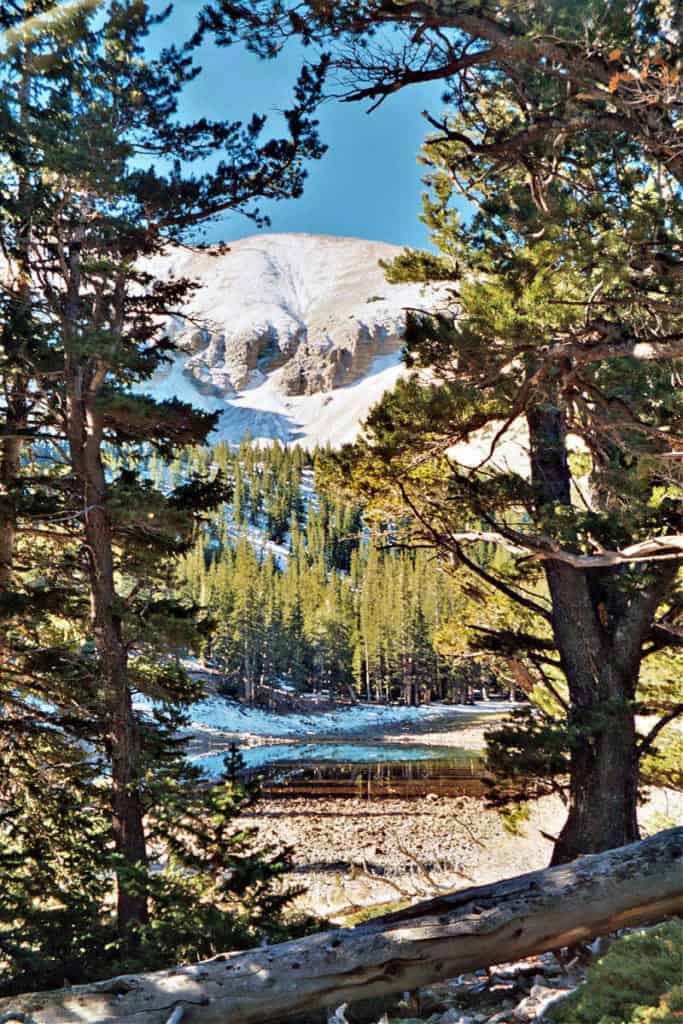
Is Great Basin National Park worth visiting?
Great Basin National Park is quite a ways off the beaten path. It’s located along U.S. Highway 50, also known as the “loneliest road in America.”
If that doesn’t tell you everything you need to know, consider that this is one of the most remote parks in the continental U.S. But don’t count it out just yet.
This is a wonderful park and absolutely worth visiting. If it seems too far out of the way, make a full trip out of it and explore some of the other parks in the (relatively) nearby vicinity.
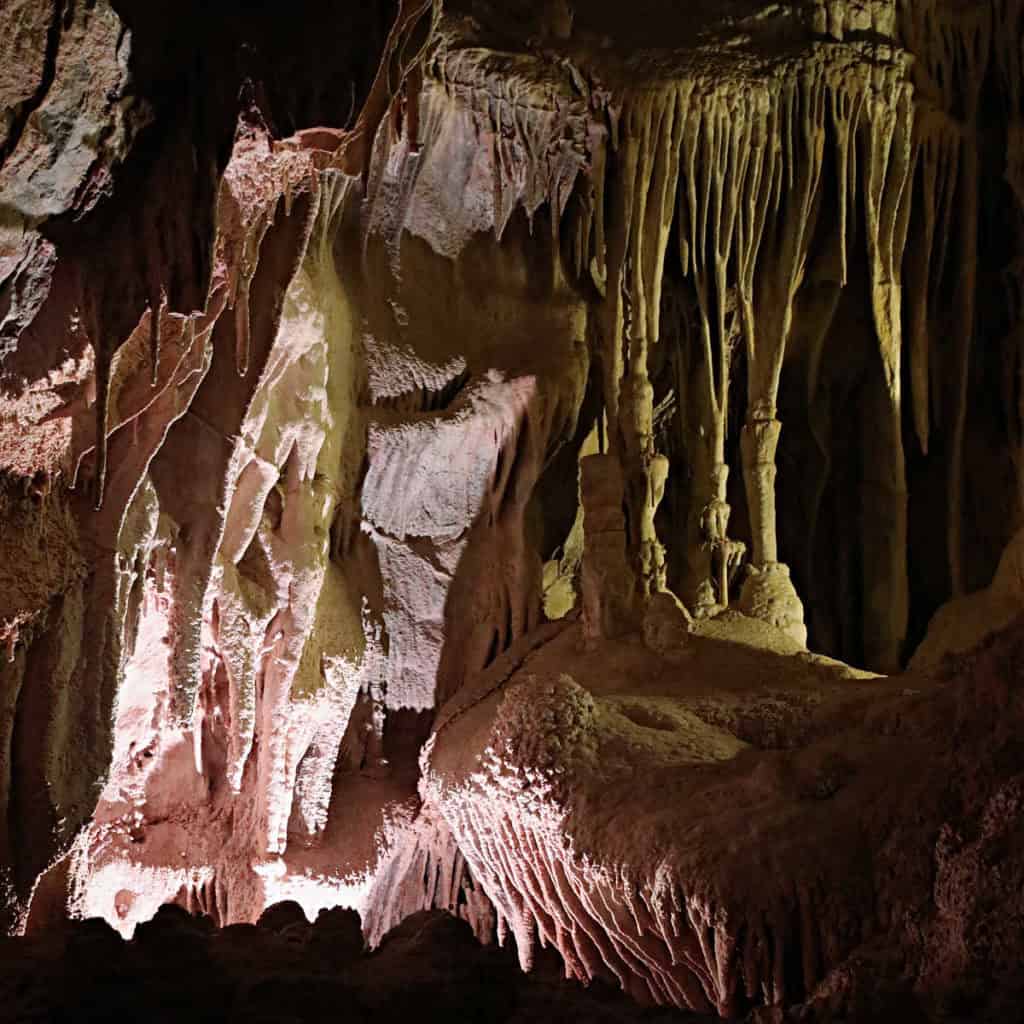
History of Great Basin National Park
The geological history of Great Basin National Park dates back millions of years, but we find the more recent human history to be much more interesting.
The Fremont Indians once called this area home, and since then, the region has played host to cave explorers, farmers, ranchers, Mormons, and miners.
The national park was created in 1986, and since its inception, it has been a priority to preserve both the natural and cultural history of the area.
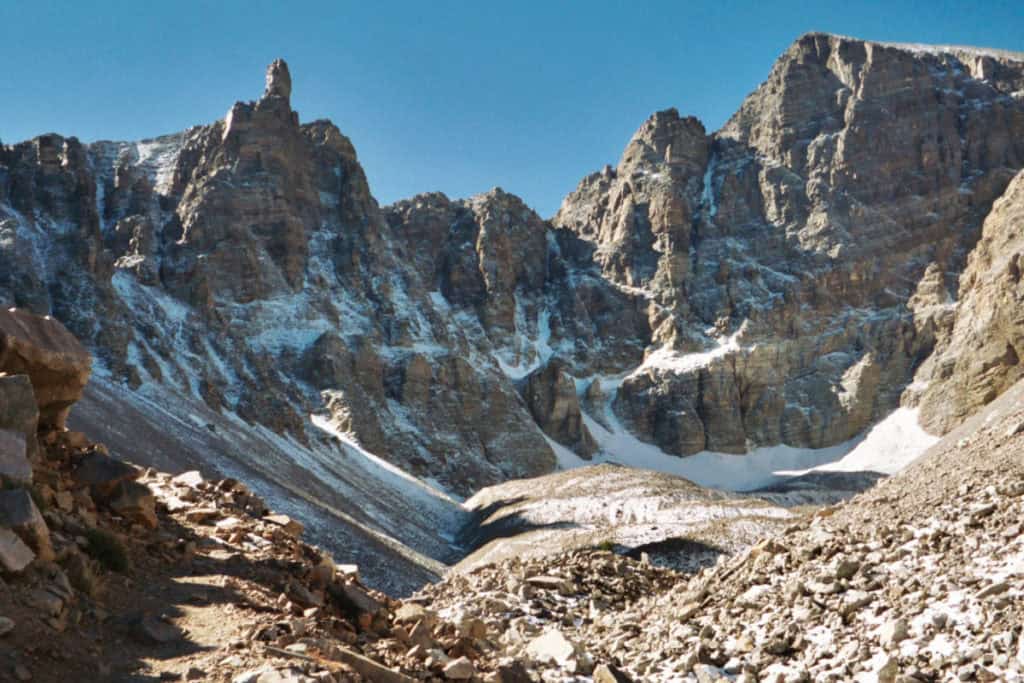
Things to know before your visit to Great Basin National Park
Great Basin National Park Entrance Fee
Park entrance fees are separate from camping and lodging fees.
Great Basin National Park does not charge an entrance fee!
Learn more about National Park Passes for parks that have an entrance fee.
$80.00 - For the America the Beautiful/National Park Pass. The pass covers entrance fees to all US National Park Sites and over 2,000 Federal Recreation Fee Sites for an entire year and covers everyone in the car for per-vehicle sites and up to 4 adults for per-person sites.

Buy your pass at this link, and REI will donate 10% of pass proceeds to the National Forest Foundation, National Park Foundation, and the U.S. Endowment for Forestry & Communities.
National Park Free Entrance Days -Mark your calendars with the five free entrance days the National Park Service offers annually.
Time Zone
Pacific Time Zone
Please check the time on your phone it is so close to Mountain Time Zone it may switch between Nevada and Utah Time.
Pets
Pets must be on a leash less than 6 feet in length at all times. Pets are not permitted in Lehman Caves or at evening programs.
Pets are not permitted on trails or in the backcountry except for on the Lexington Arch Trail or the trail between Baker and the Great Basin Visitor Center.
Cell Service
Cell service is spotty.
Park Hours
The park is open year round. Visitor services and cave tour hours vary by season with most closed in the winter.
Wi-Fi
There is no Public WIFI in the park.
Parking
There is limited parking available at the visitor centers, trailheads, campgrounds, and at various pull-outs and parking lots along Wheeler Scenic Peak Drive.
During the busy summer months parking is often hard to come by, so plan to arrive early in the day - especially on the weekends.
Food/Restaurants
There is a café and gift shop in the Lehman Caves Visitor Center open from April through October.
Gas
There are no gas stations within the park.
Drones
Drones are not permitted within National Park Sites.
Don't forget to pack
Insect repellent is always a great idea outdoors, especially around any body of water.
We use Permethrin Spray on our clothes before our park trips. Please read my article on preventing biting insects while enjoying the outdoors.
Sunscreen - I buy environmentally friendly sunscreen whenever possible because you inevitably pull it out at the beach.
Bring your water bottle and plenty of water with you. Plastic water bottles are not sold in the park.
Sunglasses - I always bring sunglasses with me. I personally love Goodr sunglasses because they are lightweight, durable, and have awesome National Park Designs from several National Parks like Joshua Tree, Yellowstone, Hawaii Volcanoes, Acadia, Denali, and more!
Click here to get your National Parks Edition of Goodr Sunglasses!
Binoculars/Spotting Scope - These will help spot birds and wildlife and make them easier to identify. We tend to see waterfowl in the distance, and they are always just a bit too far to identify them without binoculars.
Electric Vehicle Charging
There are no charging stations within 30 miles of the park.
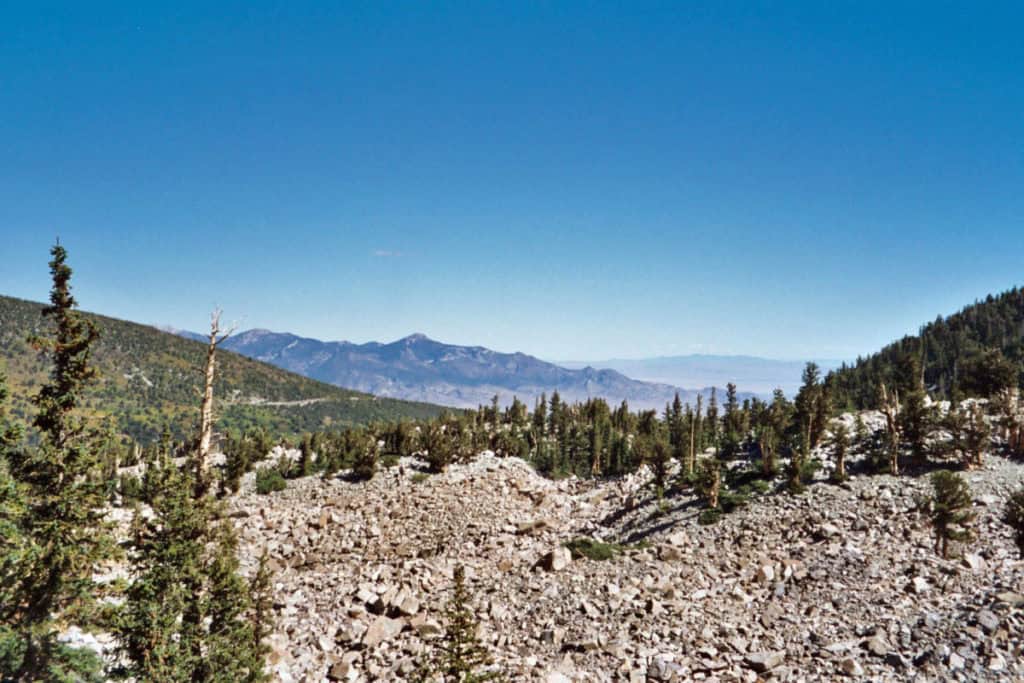
Details about Great Basin National Park
Size - 77,180 acres
Great Basin NP is currently ranked at 43 out of 63 National Parks by Size.
Date Established
1922 - President Harding proclaims Lehman Caves a National Monument.
June 10, 1933-Lehman Caves National Monument is transferred to the National Park Service jurisdiction.
October 27, 1986 - Great Basin National Park is established and Lehman Caves National Monument is incorporated into the Park
Visitation
In 2024, Great Basin NP had 152,068 park visitors.
In 2023, Great Basin NP had 143,265 park visitors.
In 2022, Great Basin NP had 142,115 park visitors.
Learn more about the most visited and least visited National Parks in the US
National Park Address
Lehman Caves Visitor Center
Nevada 488
Baker, NV 89311
Great Basin National Park Map
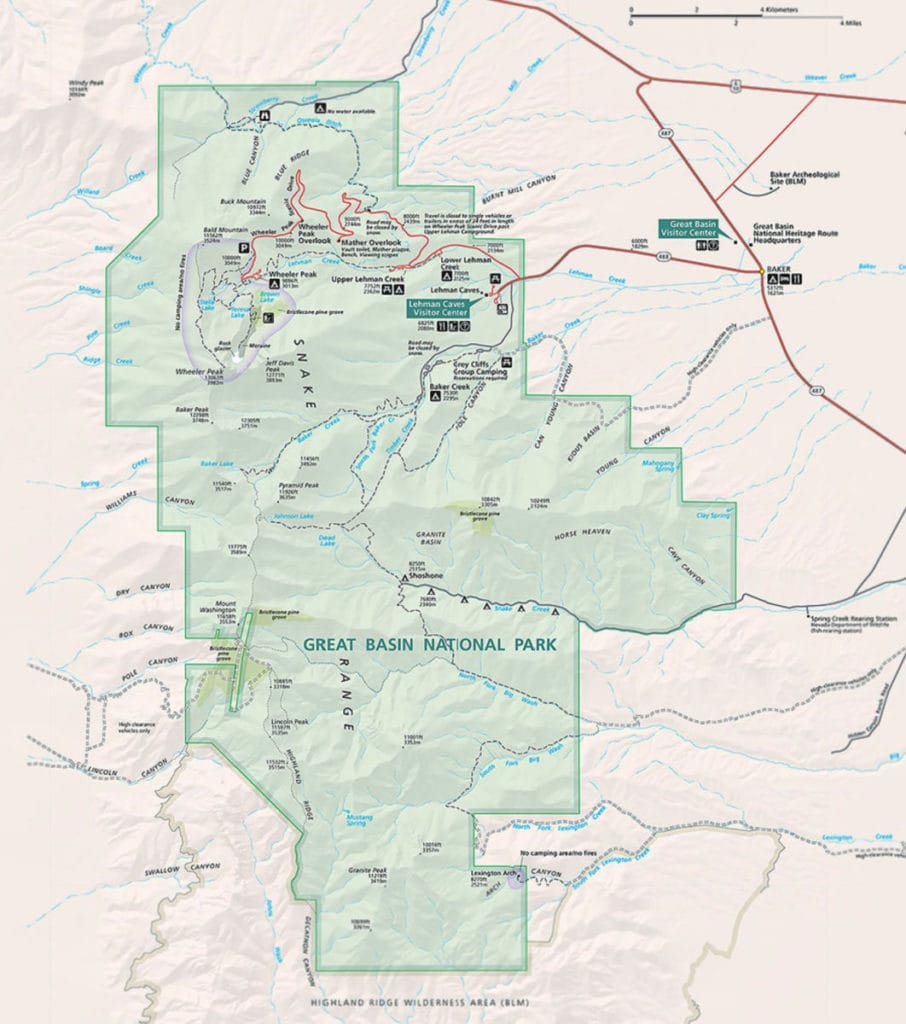
For a more detailed map we really like these National Geographic Trails Illustrated Maps available on Amazon.
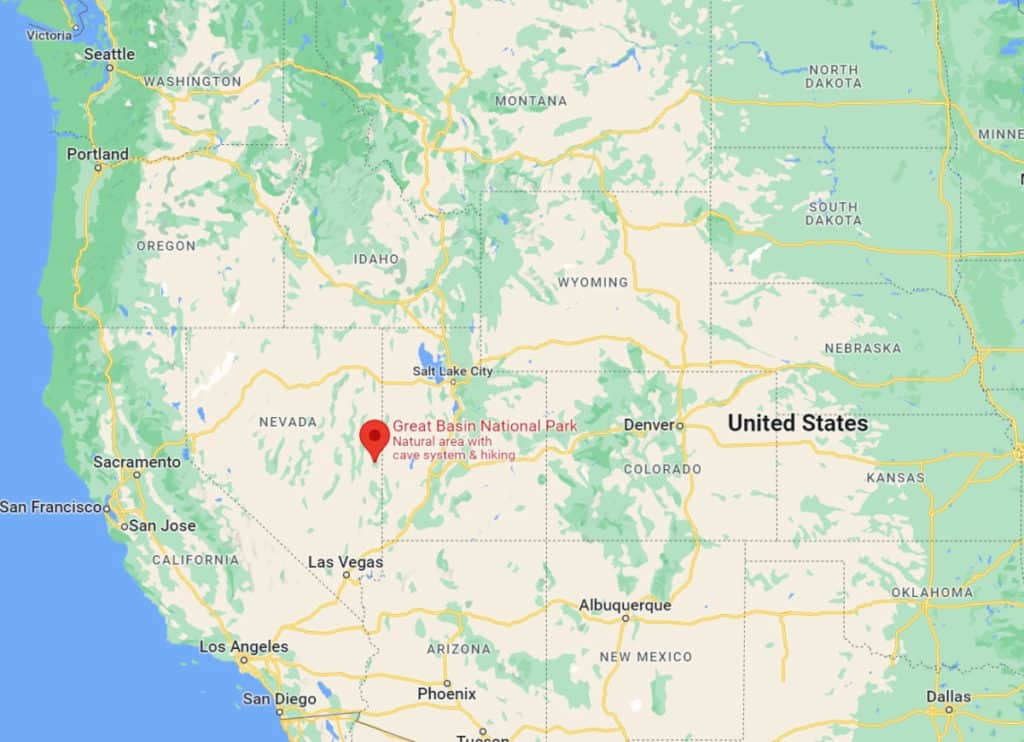
Where is Great Basin National Park?
Great Basin NP is located in east central Nevada near the town of Baker.
Estimated distance from major cities nearby
Baker, NV - 5 miles
Salt Lake City, UT - 234 miles
Cedar City, UT - 142 miles
Saint George, UT - 194 miles
Las Vegas, NV - 292 miles
Reno, NV - 383 miles
Fresno, CA - 685 miles
Boise, ID - 443 miles
Estimated Distance from nearby National Park
Bryce Canyon National Park - 188 miles
Zion National Park - 196 miles
Death Valley National Park - 366 miles
Capitol Reef National Park - 238 miles
Arches National Park - 332 miles
Canyonlands National Park - 339 miles
Where is the National Park Visitor Center?
Lehman Caves Visitor Center
Location - 5.5 miles up from the town of Baker, NV
Great Basin Visitor Center
Location - Just north of the town of Baker on the west side of NV Highway 487.
Getting to Great Basin National Park
Closest Airports
Cedar City, Utah -142 miles
St. George, Utah - 207 miles
International Airports
Salt Lake City International Airport (SLC) - 234 miles
McCarren International Airport Las Vegas (LAS) - 286 miles
Driving Directions
From the East or West: From U.S. Highway 6 & 50, turn south on Nevada State Highway 487 and travel 5 miles to Baker, NV. In Baker turn west on Highway 488 and travel 5 miles to the park.
From the South (Utah): Travel north on Utah State Highway 21 through Milford, UT and Garrison, UT, Highway 487. Turn west on Highway 488 in Baker and travel 5 miles to the park.
From the South (Nevada): Travel north on U.S. Highway 93.
Public Transportation
No public transportation is available to, or in, Great Basin National Park.
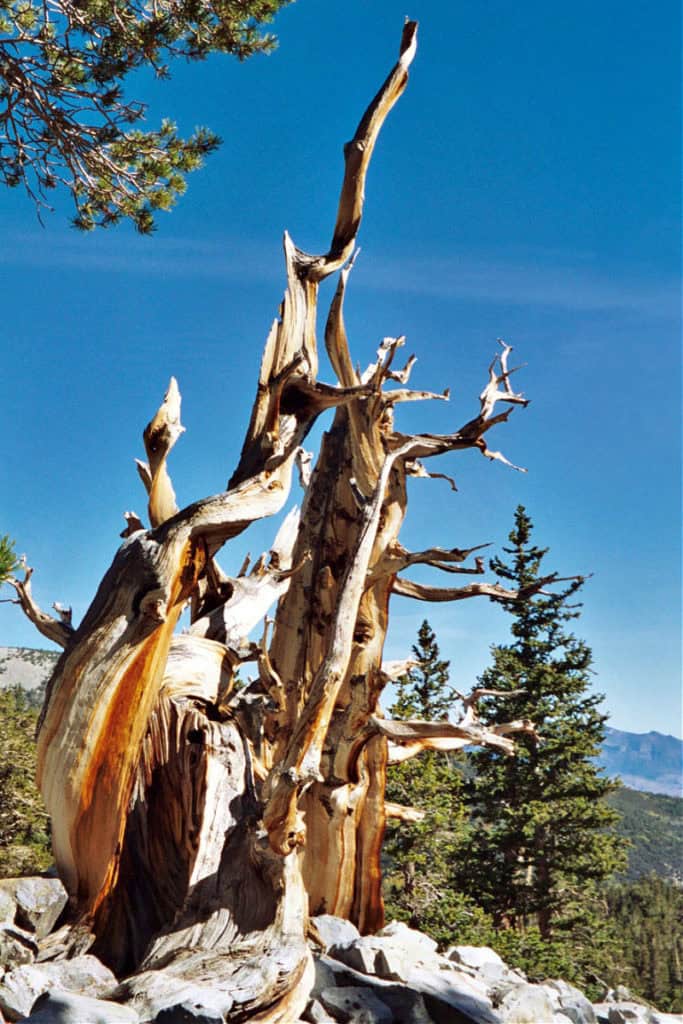
Best time to visit Great Basin National Park
Although the park is open year-round, some seasons are better for visiting than others. The weather is at its best from late May through September, so plan your trip during this window if you can.
Weather and Seasons
Spring
Spring is usually just an extension of winter at Great Basin NP, and most of it isn’t melted until the onset of summer.
Late spring can still be a good time to visit, as temperatures begin to rise and visitation is still low.
Summer
Summer is by far the busiest time of year to visit Great Basin NP.
The weather is great, with highs in the mid-80s and lows in the 50s, and all the park activities are in full swing.
Rain showers and thunderstorms can occur in the afternoons, so try to start your days early, especially if you plan on hiking one of the longer trails.
Summer is also a great time for stargazing, thanks to the mild temperatures. On a clear night, you’ll get the best visibility of the Milky Way in the continental U.S.!
Fall
Fall is a wonderful time to visit the park, especially if you want to avoid the crowds.
This is when many of the locals choose to explore Great Basin, as the crisp air and colorful foliage present the perfect hiking opportunities.
Note that snowfall is not uncommon later in this season, so September and October are typically more ideal for visiting than November.
Winter
Winter is the best time of year to visit if you hope to have the park all to yourself.
That being said, many of the main highlights are unavailable due to the snow, including Wheeler Peak Scenic Drive and most of the hiking trails.
However, the Lehman Caves Visitor Center remains open year-round, and the snow allows for cross country skiing and snowshoeing.
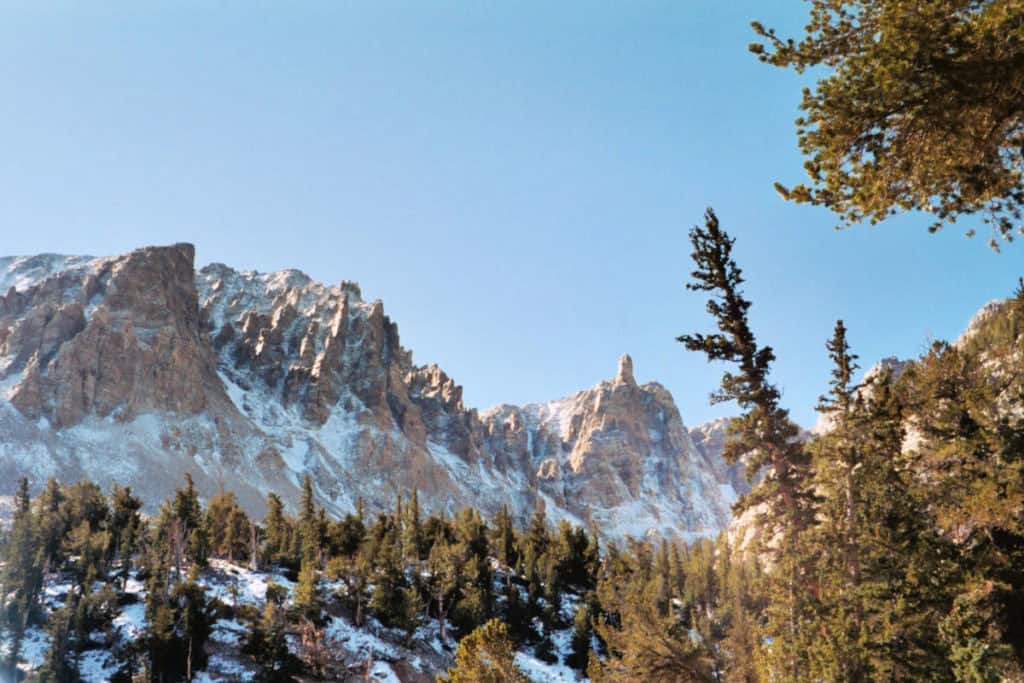
Best Things to do in Great Basin National Park
We suggest planning a couple of days to explore Great Basin NP. You want to plan time especially if you want to do a cave tour and a big hike.
Lehman Caves Tour
Great Basin National Park is home to Nevada’s longest cave system - the Lehman Caves. While you’re here, taking a tour of the caves is simply a must. The limestone caves are known for having numerous stalactites, stalagmites, popcorn, and shield formations.
Tours are ranger-led and range in time and length. The cave system stays at a constant 50° Fahrenheit year-round, so dress accordingly. Shoes with good traction are also a good idea as the trails are often wet and slippery.
Advanced reservations are highly recommended, especially during the busy summer months. Tours are available daily, year-round, with the exception of certain holidays.
Junior Ranger Program
The Junior Ranger Program is a great way to do a deep dive into Great Basin National Park.
If you want to learn all about Great Basin’s caves, flora and fauna, and more in a fun, hands-on way, make sure to enroll in the Junior Ranger Program.
This is a great activity for visitors of all ages, so don't hesitate to complete this fun program even if you’re not traveling with kids!
Bird/Wildlife Watching
The diverse ecosystems within Great Basin National Park mean that there is a wide variety of wildlife living in this region.
Keep your eyes peeled as you drive and hike, and you might see bighorn sheep, porcupines, beavers, rabbits, deer, and more.
The ever-changing landscape also supports many different bird species.
Look overhead for great blue heron, northern pintail, and mallards flying from one pond to another, and if you’re walking in the Lehman Creek area, watch for woodpeckers, sapsuckers, warblers, and mountain chickadees, among many others.
Wheeler Peak Scenic Drive
Taking a cruise along the Wheeler Peak Scenic Drive is one of the best things to do in Great Basin National Park.
This 12-mile route goes all the way up to Wheeler Peak and offers up spectacular views along the way.
There are quite a few scenic lookout points that you can pull off at to take in the views as you drive, and you’ll likely see some wildlife, too.
This drive can get busy in the summer, so take it slow and enjoy the view! Note that due to snow, Wheeler Peak Scenic Drive is usually only accessible from late spring into early autumn.
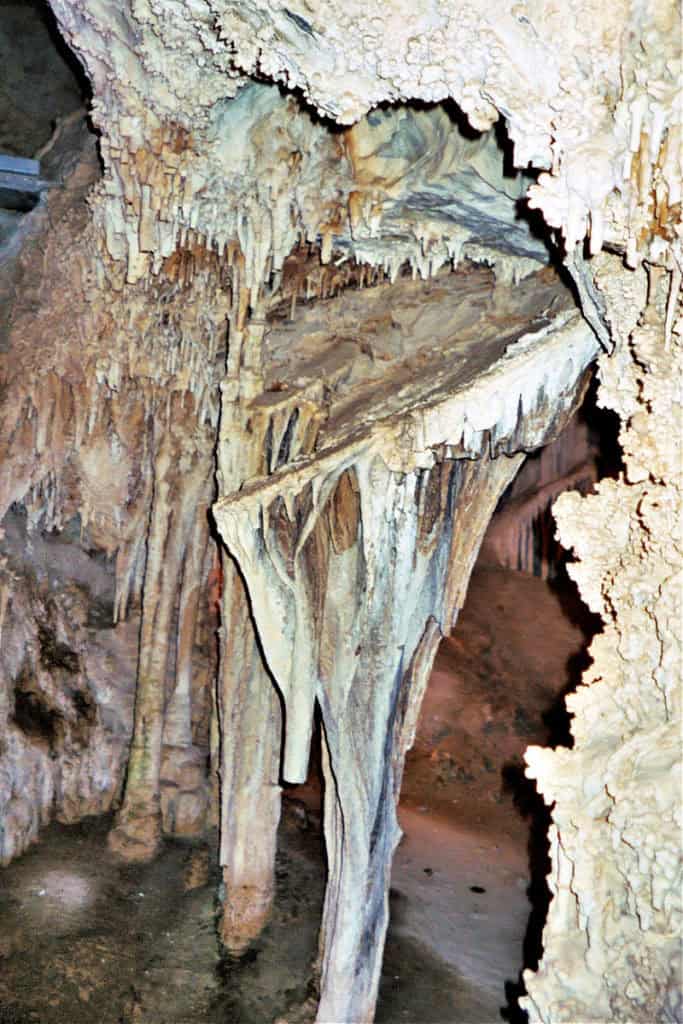
Hiking in Great Basin National Park
Always carry the 10 essentials for outdoor survival when exploring.
Hiking is one of the best ways to explore Great Basin National Park.
The park trails wind through the ever-changing landscapes, from glacial lakes and high alpine forests to ancient tree groves and historic mining channels. Below are a few of the best hiking trails in Great Basin National Park.
Note that Great Basin is located at a high altitude, meaning that even the easiest trails pose a challenging element to visitors coming from lower altitudes.
Take the trails slow, and don’t hesitate to take lots of breaks along the way.
Sky Island Forest Trail
Distance - 0.3 miles
Trail Difficulty - Easy
Time Required - 10 Minutes
Trailhead - Wheeler Peak Campground
Sky Island Forest Trail is an ADA-accessible route that leads through a high alpine conifer forest. There are interpretive signs along the way depicting the area’s history.
There are also several streams and lookout points on this route. Note that snow makes this trail inaccessible in the winter and early spring.
Mountain View Nature Trail
Distance - 0.4 miles
Trail Difficulty - Easy
Time Required - 10 min
Trailhead - Lehman Caves Visitor Center
This quick and easy jaunt starts at the Lehman Caves Visitor Center and winds through a pinyon-juniper forest.
Some might not consider it a true hike, but at the very least, it's a great way to pass some time if you’re waiting to go on a cave tour!
Osceola Ditch Interpretive Trail
Distance - 2.7 miles
Trail Difficulty - Easy
Time Required - 1 hour
Trailhead - Wheeler Peak Scenic Drive
The Osceola Ditch Interpretive trail is part of an 18-mile-long channel created by gold miners in the 1880s.
You’ll hike through a forest of ponderosa pine, douglas fir, and white fir with interpretive signs depicting the history of this area.
You’ll even be able to see some ruins from the mining area as you hike. If you’d like to extend your hike, simply continue walking along the Osceola Ditch and turn around when it ends.
Alpine Lakes Loop Trail
Distance - 2.7 miles
Trail Difficulty - Easy
Time Required - 1.5 hours
Trailhead - Wheeler Peak Scenic Drive / Wheeler Peak Campground
If you’re already driving up to Wheeler Peak, then hiking this easy trail is a must. You’ll pass by two alpine lakes and tons of stunning mountain views.
Bristlecone and Glacier Trail
Distance - 4.5 miles
Trail Difficulty - Moderate
Time Required - 2.5 hours
Trailhead - Wheeler Peak Scenic Drive / Wheeler Peak Campground
If you only have time to hike one trail during your time in Great Basin, make it the Bristlecone Pine Trail.
This route encompasses all the best aspects of the park, including beautiful alpine lakes, hiking through ancient bristlecone pines, and towering mountain peaks.
At the top, you’ll even be able to see Nevada’s only glacier, Rock Glacier, though it is hidden under some rock debris below Wheeler Peak.
Johnson Lake Trail from Snake Creek
Distance - 7 miles
Trail Difficulty - Hard
Time Required - 4 hours
Trailhead - Snake Creek Road
With most of the route being at a steep incline, this trail is a real leg burner.
As you hike, you’ll be treated to views of the Snake Creek drainage before reaching the lake at the summit.
The summit area is also home to the historic Johnson Lake Mine, and some old cabin ruins from this era are still standing. Do not enter these buildings! They are not reinforced in any way.
Lehman Creek Trail
Distance - 8.2 miles
Trail Difficulty - Hard
Time Required - 4.5 hours
Trailhead - Wheeler Peak Scenic Drive / Lower Lehman Campground OR Wheeler Peak Campground
This trail stretches from Lower Lehman Campground to Wheeler Peak Campground (or vice-versa) and meanders through the different habitats of the creek area.
Bird watching is especially great along this route, as are the views.
Wheeler Peak Summit Trail
Distance - 8.2 miles
Trail Difficulty - Hard
Time Required - 5 hours
Trailhead - Wheeler Peak Scenic Drive
Summit the tippy top of the 13,063-foot summit of Wheeler Peak, the second tallest peak in Nevada.
This trail is long and strenuous, but the views from the summit will give you a feeling of being on top of the world.
Summer is the best time for hiking this trail, as you’re almost guaranteed that no snow will impede your way to the top.
Be sure to start early, though - afternoon summer thunderstorms can really put a damper on things!
Baker Lake Trail
Distance - 10.4 miles
Trail Difficulty - Hard
Time Required - 5.5 hours
Trailhead - Baker Creek Road
Baker Lake is an alpine lake surrounded by jagged mountain peaks. While it’s no easy task to complete this lengthy trail, the views from the lake are well worth the effort.
How to beat the crowds in Great Basin National Park?
Summer is the busiest time of year at Great Basin National Park. If this is the only time you can visit, try to plan your trip for a weekday.
Be sure to arrive early in the day during the summer months, no matter what day of the week you’re there.
You can also avoid the summer crowds by visiting the more remote areas of the park, though many of these roads require a high clearance four-wheel drive vehicle.
You could also plan your trip to Great Basin National Park during the shoulder seasons.
Late May and early September are great options, as the weather is still pleasant but the crowds are somewhat more sparse.
Where to stay when visiting Great Basin National Park
There are no National Park Lodges in Great Basin NP. There is lodging nearby in Baker, Nevada
The majority of lodging for Great Basin NP can be found in Ely, Nevada about an hour from the park.
La Quinta Inn & Suites by Wyndham Ely - We stayed in this hotel during our last visit to the park and it was great. Free continental breakfast, a free manager's reception, and a fireplace in the lobby. For some rest and relaxation, visit the hot tub. Stay connected with free in-room Wi-Fi, and guests can find other amenities such as a gym and a 24-hour business center.
Holiday Inn Express & Suites Ely - Free continental breakfast, laundry facilities, and a 24-hour gym are just a few of the amenities provided at Holiday Inn Express & Suites Ely, an IHG Hotel. Treat yourself to some rest and relaxation at Steam Room, the onsite spa. In addition to a 24-hour business center and a steam room, guests can connect to free in-room Wi-Fi.
Hotel Nevada - We stayed in this historic casino hotel during one of our trips to the park. It is definitely a historic hotel.
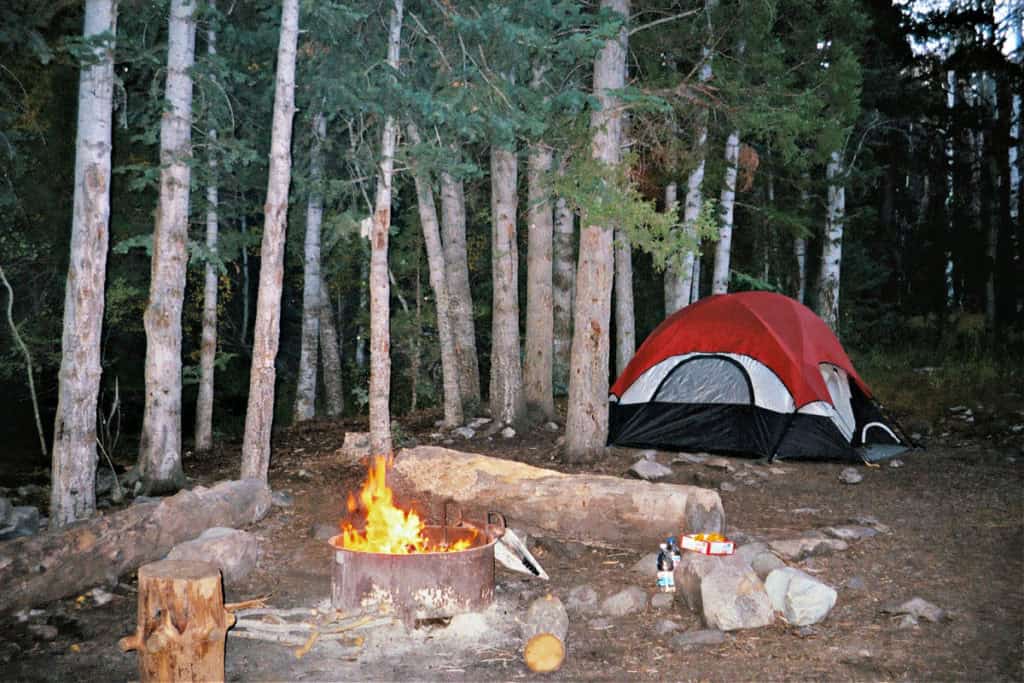
Great Basin Camping
All five of the developed campgrounds are equipped with vault toilets, and each site contains a picnic table, campfire grill, and tent pad. There are no hook-ups available.
Lower Lehman Creek Campground
11 sites. Open year-round. Reservations required Memorial Day through Labor Day.
Upper Lehman Creek Campground
22 sites. Open from mid-April through October. Reservations required Memorial Day through Labor Day.
Wheeler Peak Campground
37 sites. Open June to October. Reservations required Memorial Day through Labor Day.
Baker Creek Campground
38 sites. Open May to October. Fist-come-first-served.
Grey Cliffs Campground
16 sites. Open Memorial Day to Labor Day. Reservations required.
Primitive Campgrounds
There is currently one primitive campground available at Great Basin National Park. Each site contains a picnic table and fire ring.
Snake Creek Campground
12 sites. Open year-round - may close in the winter due to snow.
Backcountry Camping
Backcountry camping is allowed in most of the park, though some areas are off-limit. See the park website for more details.
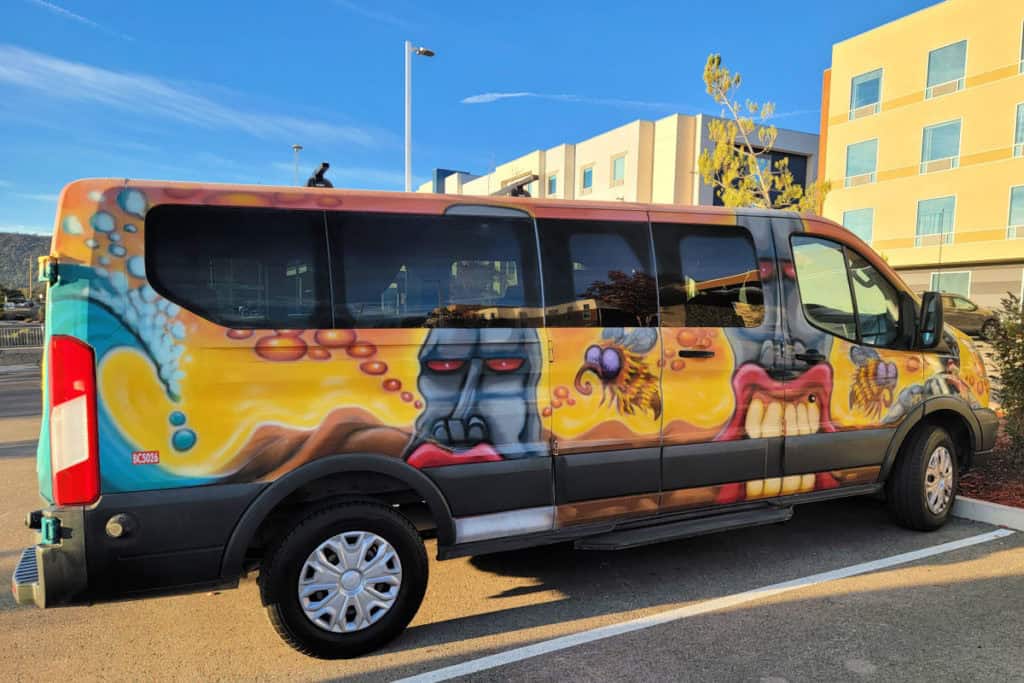
For a fun adventure check out Escape Campervans. These campervans have built in beds, kitchen area with refrigerators, and more. You can have them fully set up with kitchen supplies, bedding, and other fun extras. They are painted with epic designs you can't miss!
Escape Campervans has offices in Vancouver, Seattle, Portland, San Francisco, Las Vegas, Los Angeles, Phoenix, Salt Lake City, Denver, New York, and Orlando
Parks Near Great Basin National Park
Cedar Breaks National Monument - 152 miles
Timpanogos Cave National Monument - 206 miles
Lake Mead National Recreation Area - 333 miles
Tule Springs Fossil Beds National Monument - 300 miles
Golden Spike National Historical Park - 319 miles
Dinosaur National Monument - 349 miles
Fossil Butte National Monument - 350 miles
Check out all of the Nevada National Parks along with neighboring National Parks in Oregon, National Parks in Idaho, Utah National Parks, California National Parks, and Arizona National Parks
Nearby Nevada State Parks include Cathedral Gorge State Park and Cave Lake State Park.
